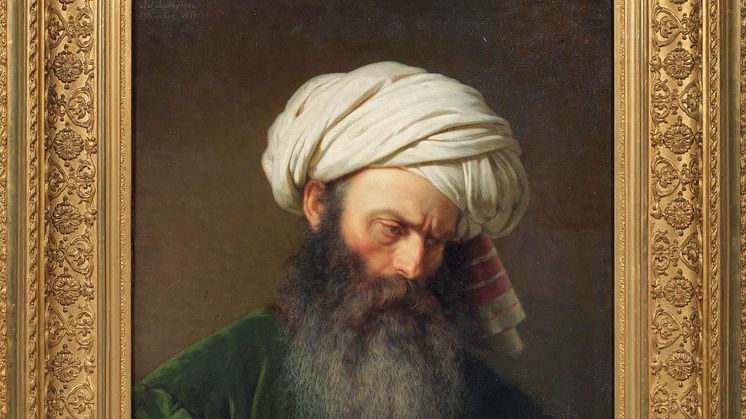
Press release -
New acquisition: Study of a man in Turkish dress by Amalia Lindegren
Nationalmuseum has acquired a study of a man in Turkish dress by Amalia Lindegren, a significant addition to the museum’s collection of works by female artists. The painting was a prize in a Christmas lottery run by the Swedish Association for Art in 1854 and was won by Fredrik Bergwall, a manufacturer from Norrköping. Until now, it has remained in his family’s possession.
To bolster its collection of works by female artists, Nationalmuseum has acquired a fine head study by Amalia Lindegren (1814–91). During her lifetime, Lindegren enjoyed great success as an artist, known chiefly for her portraits and genre paintings. She has been represented in Nationalmuseum’s collection for over 160 years. Girl with an Orange, painted in 1855, was one of four works purchased when the Swedish government first allocated funding to Nationalmuseum for new acquisitions – exemplifying the contemporary art of the time.
In Lindegren’s youth, women still had no access to advanced artistic education in Sweden. In 1847, she was granted a special dispensation to study classical art at the Royal Swedish Academy of Fine Arts. It would be another decade and a half before women were accepted as regular students. Then, in 1850, Lindegren became the first Swedish woman to receive a government scholarship to pursue art studies abroad. Her main destination was Paris, but she also spent some time in Munich, an artistic metropolis associated especially with historical painting.
One of the paintings she produced in Munich in the spring of 1854 was this head study of a man with a large, grey-flecked beard, wearing a turban and a green kaftan edged in a gold pattern. The subject is looking down with an introspective gaze. Lindegren wrote to the Academy of Fine Arts that she had completed a painting “depicting a man in Turkish dress (head and shoulders)”, and the head study was sent back to Stockholm. Keeping in touch by letter was not enough to ensure an extension of the government scholarship; it was necessary to show tangible results in the form of artworks. On 22 December 1854, under the title Turk’s Head, this painting was offered as a prize in a Christmas lottery run by the Swedish Association for Art. The winner was Fredrik Bergwall, a manufacturer from Norrköping, and the painting has remained in his family’s possession until now.
In her letter to the Academy, Lindegren also mentioned that she was working on a painting of Saint Matthew the Evangelist. The present whereabouts of that work are unknown, but the motif is not far removed from this head study. A man wearing a turban and kaftan would also be relevant in a biblical context. In both Old and New Testament scenes, artists often depicted people in the Middle Eastern forms of dress found in the Holy Land. It is not known whether Lindegren had an oriental or biblical motif in mind when she painted this study. Nevertheless, the painting has several noteworthy qualities. It is a subtle human portrait with some reflective, melancholic touches.
Unlike in 1855, Nationalmuseum today has no budget allocation from the government for new acquisitions, relying instead on gifting and financial support from private funds and foundations to enhance its collections of fine art and craft. The purchase of this work was made possible by a generous donation from the Hedda and N.D. Qvist Memorial Fund.
Press contacts
Eva-Lena Karlsson, Collection Curator, National Portrait Collection:eva-lena.karlsson@nationalmuseum.se, +46 8 5195 4430
Hanna Tottmar, Press Officer:hanna.tottmar@nationalmuseum.se, +46 767 234632
Caption
Amalia Lindegren, Study of a man in Turkish dress, 1854. Photo: Anna Danielsson/Nationalmuseum.
Categories
Nationalmuseum is Sweden’s premier museum of art and design. The collections comprise older paintings, sculpture, drawings and graphic art, and applied art and design up to the present day. The museum building is currently under renovation and scheduled to open again in 2018. In the meantime, the museum will continue its activities through collaborations both in Sweden and abroad as well as temporary exhibitions at the Royal Swedish Academy of Fine Arts, Fredsgatan 12 and Nationalmuseum Design at Kulturhuset Stadsteatern in Stockholm. Nationalmuseum has partnerships with Svenska Dagbladet and the Grand Hôtel Stockholm, and acknowledges the support of FCB Fältman & Malmén.

